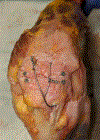Transverse patella fracture fixation: A cadaveric biomechanical comparison of cannulated screws and anterior tension band versus low-profile, multiplanar mesh plating
- PMID: 38669892
- PMCID: PMC11111345
- DOI: 10.1016/j.injury.2024.111574
Transverse patella fracture fixation: A cadaveric biomechanical comparison of cannulated screws and anterior tension band versus low-profile, multiplanar mesh plating
Abstract
Introduction: Multiplanar mesh plating of patella fractures has become more popular in recent years. It was the goal of this study to compare the biomechanical stability of cannulated screw with anterior tension band to multiplanar mesh plating for fixation of transverse patella fractures in cadaver specimens.
Materials and methods: Eight matched pairs of fresh frozen cadaveric knees were obtained and soft tissues dissected leaving the extensor mechanism, joint capsule, and retinaculum intact. Transverse fractures were created at the mid-portion of the patella. For each pair, one specimen was repaired using cannulated screws with anterior tension band, and the second was repaired using multiplanar mesh plating. Each specimen underwent cyclic extension loading with loads increasing by 1.1 kg after every 50 cycles. Interfragmentary displacement was measured at the end of each interval at both 5° and 45° of knee flexion angle, with fixation failure defined by >2 mm displacement.
Results: The specimens fixed with multiplanar mesh plating survived more cycles and higher loads than the specimens fixed with cannulated screws with anterior tension band (p = 0.011 comparing survival plots). After 150 cycles of extension loading, 3 of 8 of the specimens fixed with screws/tension band had failed, whereas none of the mesh plated specimens had failed. After 400 cycles, 7 of 8 of the screws/tension band had failed, whereas half of the mesh plated specimens had failed.
Conclusions: While a more technically challenging and expensive technique, mesh plating for patella fractures appears to offer greater durability than traditional cannulated screw with tension banding.
Keywords: Mesh plating; Patella fracture; Tension band.
Copyright © 2024. Published by Elsevier Ltd.
Conflict of interest statement
Declaration of competing interest Implants for the study were provided by Johnson & Johnson Depuy Synthes. Additional support provided by National Institute of Biomedical Imaging and Bioengineering award R01EB029207
Figures





References
-
- Lazaro LE, Wellman DS, Sauro G, Pardee NC, Berkes MB, Little MT, et al. Outcomes after operative fixation of complete articular patellar fractures: assessment of functional impairment. J Bone Joint Surg Am. 2013. Jul;95(14):e96 1–8. - PubMed
-
- Hambright DS, Walley KC, Hall A, Appleton PT, Rodriguez EK. Revisiting Tension Band Fixation for Difficult Patellar Fractures. J Orthop Trauma. 2017. Feb;31(2):e66–e72. - PubMed
-
- Hsu KL, Chang WL, Yang CY, Yeh ML, Chang CW. Factors affecting the outcomes of modified tension band wiring techniques in transverse patellar fractures. Injury. 2017. Dec;48(12):2800–6. - PubMed
-
- Wild M, Khayal T, Miersch D, Windolf J, Hakimi M. [Dynamic cerclage wiring of patellar fractures. Complications and midterm functional results]. Unfallchirurg. 2008. Nov;111(11):892–7. - PubMed
-
- LeBrun CT, Langford JR, Sagi HC. Functional outcomes after operatively treated patella fractures. J Orthop Trauma. 2012. Jul;26(7):422–6. - PubMed
Publication types
MeSH terms
Grants and funding
LinkOut - more resources
Full Text Sources
Medical

